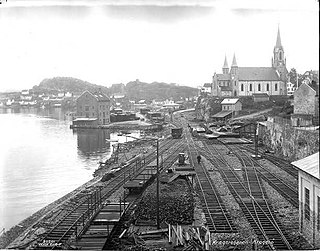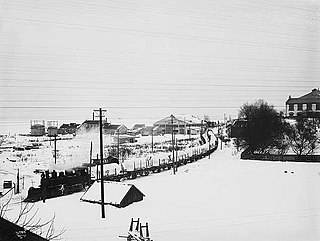
The Nordland Line is a 729-kilometer (453 mi) railway line between Trondheim and Bodø, Norway. It is the longest in Norway and lacks electrification. The route runs through the counties of Trøndelag and Nordland, carrying a combination of commuter, long-haul passenger and freight trains. From Trondheim Central Station to Steinkjer Station the line is most heavily used, with hourly services by the Trøndelag Commuter Rail. There are three branch lines—the Stavne–Leangen Line at Leangen Station, the Meråker Line at Hell Station and the Namsos Line at Grong Station.

The Arendal Line is a 45-kilometer (28 mi) long railway line between Arendal and Simonstad in Norway. At Nelaug, 37 kilometers (23 mi) north of Arendal, the line intersects with the Sørland Line. The southern section is electrified and provides a feeder passenger service. The line originally ran 90 kilometers (56 mi) north from Arendal to Treungen and the lake Nisser, but the upper-most part has been removed. The line is owned by the Bane NOR and operated by Go-Ahead Norge using Class 69 trains.

The Bratsberg Line is a 74-kilometre long (46 mi) railway line between Eidanger and Notodden in Telemark county, Norway. It opened in 1917, connecting the Tinnos Line, the Sørland Line and the Vestfold Line; allowing Norsk Hydro to transport fertilizer from their plant at Rjukan to the port in Skien. Since 1991 only passenger trains are operated, using Class 69 stock by Vy.

The Oslo Tunnel is a 3,632-metre (2.257 mi), double-track, railway tunnel which runs between Olav Kyrres plass and Oslo Central Station (Oslo S) in Oslo, Norway. The tunnel constitutes the easternmost section of the Drammen Line and runs below the central business district of Oslo. It features the four-track Nationaltheatret Station, Norway's second-busiest railway station, where the Oslo Tunnels lies directly beneath the Common Tunnel of the Oslo Metro. At Frogner, the Elisenberg Station was built, but has never been used. The tunnel is the busiest section of railway line in Norway and serves all west-bound trains from Oslo, including many services of the Oslo Commuter Rail and the Airport Express Train.

The Numedal Line is a 92.8-kilometer (57.7 mi) long railway line that runs up the Numedal valley between Kongsberg and Rødberg in Buskerud county, Norway. Built and operated by the Norwegian State Railways, the non-electrified, standard gauge line passes through the municipalities of Kongsberg, Flesberg, Rollag and Nore og Uvdal. It is now owned by the Norwegian National Rail Administration.

The Kragerø Line was a 27-kilometer (17 mi) long railway line between Neslandsvatn and Kragerø in Telemark county, Norway. It was opened on 2 December 1927 as part of the Sørlandet Line. From 10 November 1935, the Sørlandet Line was extended from Neslandsvatn to Arendal, and the Kragerø Line became a branch. It was mostly served with feeder trains, although a through train to Oslo was kept until the 1970s. Falling ridership caused the line to become closed from 1 December 1989, along with many other branch lines. Part of the line remains, although other parts have been demolished.

The Asker Line is a 9.5-kilometre (5.9 mi) railway line between Asker and Lysaker in Norway. The line runs along the same corridor as the Drammen Line, offering increased capacity, speed and regularity on the rail network west of Oslo. The first part opened in 2005, and in 2011 an extension opened from Sandvika to Lysaker. Original plans called for an extension to Skøyen, but from 2020, new planning is under way for an extension all the way to Oslo Central Station. Most of the railway is in tunnel and is dimensioned for 160 km/h (99 mph) running. The entire railway is electrified at 15 kV 16.7 Hz AC. The first section cost 3.7 billion kr, while the second is budgeted at NOK 2.7 billion.

The Grimstad Line was a 22-kilometer (14 mi) long railway line between Grimstad and Rise in Norway. The line was a branch of the Arendal Line, which is in turn a branch of the Sørland Line. Opened as the Grimstad–Froland Line on 14 September 1907, it was originally a private railway. The line was nationalized and taken over by the Norwegian State Railways in 1912. The railway was originally built with 1,067 mm narrow gauge, but was converted to standard gauge in 1936. Because of the cumbersome transfers, the line had few passenger and little freight. It was closed and demolished in 1961.

Hamar Station is a railway station of the Dovre Line and the Røros Line located in downtown Hamar, Norway. Located 126.26 kilometers (78.45 mi) from Oslo Central Station, it is served by long-distance and regional trains on the Dovre Line, as the terminus for regional trains on the Røros Line. All trains are operated by SJ Norge, except the regional trains between Lillehammer and Oslo, which are operated by Vy. A side platform and an island platform are in regular use. The station handled 1,062,300 passengers in 2008.

The Holmestrand–Hvittingfoss Line or HVB is an abandoned railway between Holmestrand to Hvittingfoss in Norway. It consisted of two sections: a 13.4-kilometer (8.3 mi) line from Holmestrand to Hillestad and a 10.4-kilometer (6.5 mi) section from Hof to Hvittingfoss. The two parts were connected by a 6 kilometers (4 mi) section of the Tønsberg–Eidsfoss Line. At Holmestrand Station, the line connected to the Vestfold Line of the Norwegian State Railways. HVB was opened on 30 September 1902 and closed on 1 June 1938. The main purpose of the line was the transport of wood pulp at Hvittingfoss, although it was also used for passenger transport until 1931.

The Tønsberg–Eidsfoss Line or TEB is an abandoned railway between Eidsfoss and Tønsberg in Vestfold county, Norway. In use from 21 October 1901 to 31 May 1938, the private railway connected the area of Hof to Tønsberg, the coast and the Vestfold Line of the Norwegian State Railways. The main purpose of the 48.10-kilometre (29.89 mi) narrow gauge railway was to connect Eidsfos Verk to the mainline, although the railway also operated passenger trains. The line shares 6 kilometres (3.7 mi) with the Holmestrand–Vittingfoss Line (HVB), the two which from 1934 were operated by the same company, Vestfold Privatbaner.

Nelaug Station is a railway station located at the village of Nelaug in Åmli municipality in Agder county, Norway. The station sits just north of the lake Nelaug. The station functions as a meeting station of the Sørlandsbanen and Arendalsbanen railway lines. The Arendalsbanen line is a branch line that runs from Nelaug to Arendal Station. Passengers from Oslo to Arendal must change trains at Nelaug. The station was opened on 10 November 1910, and in 1935, a new building was completed.

Kragerø Station was a railway station located in Kragerø, Norway on the Kragerø Line.

Rise Station is a railway station at Rise in Arendal, Norway. Located on the Arendal Line, it is served by the Go-Ahead Norge. The station opened as the terminus of the Grimstad Line in 1907; the following year it became a transfer station to the Arendal Line. It then received a station building designed by Paul Armin Due. In 1935 and 1936, the lines were converted from narrow gauge to standard gauge, although for a year the station served as a break-of-gauge station. The Grimstad Line closed in 1961 and in 1983 the station was unmanned.

Bråstad Station is a railway station at Bråstad in Arendal, Norway. Located on the Arendal Line it is served by Go-Ahead Norge. The station was opened as part of Arendal–Åmli Line on 23 November 1908 and originally consisted of a station building designed by Paul Armin Due, a guard house and a loading spur. The station was called Braastad until 1921 and remained staffed until 1928. Since the 1980s, the station has consisted of a shed and platform.
Johan Henrik Kintzell Frøstrup was a Norwegian judge and politician for the Conservative Party

Nikolai Christian Grove Prebensen was a Norwegian politician for the Conservative Party.
Torbjørnsbu Station is a former railway station at Torbjørnsbu in Arendal, Norway. Located on the Arendal Line, it was operated by the Norwegian State Railways. The station was opened on 1 May 1911 and originally consisted of a station building and a loading spur. The station remained staffed until 1939 and was later closed.

Rossedalen Station is a former railway station at Rossedalen in Arendal, Norway. Located on the Arendal Line, it was operated by the Norwegian State Railways. The station was opened on 1 May 1911 and originally consisted of a small station building. The station has never been staffed and has never had a spur or passing loop.

Holmestrand Private Station was a railway station located in Holmestrand, Norway. It served as the terminus station of the private Holmestrand–Vittingfoss Line (HVB), which was in use between 1902 and 1937. The station was connected to the Norwegian State Railways' (NSB) Holmestrand Station on the Vestfold Line.




















